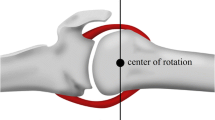Abstract
After placement of a reverse shoulder endoprosthesis, range of motion is usually still compromised. To what extent this occurs from limitation in motion of the reverse endoprosthesis is, however, unclear. We measured the motion pattern of 16 patients (18 shoulders) during three active and passive range of motion tasks using a six degree-of-freedom electromagnetic tracking device. Despite rotator cuff deficiencies, glenohumeral elevation contributed roughly two-thirds of the total thoracohumeral elevation, which is comparable to healthy subjects. However, patients could not actively use the full range of motion provided by the prosthesis. Although we found considerable interindividual differences in shoulder kinematics, the limitation in glenohumeral range of motion appears related to a lack of generated muscle force and not the design of the prosthesis.
Level of Evidence: Level IV, therapeutic study. See the Guidelines for Authors for a complete description of levels of evidence.

Similar content being viewed by others
References
Boileau P, Watkinson DJ, Hatzidakis AM, Balg F. Grammont reverse prosthesis: design, rationale, and biomechanics. J Shoulder Elbow Surg. 2005;14(Suppl S):147S–161S.
Boulahia A, Edwards TB, Walch G, Baratta RV. Early results of a reverse design prosthesis in the treatment of arthritis of the shoulder in elderly patients with a large rotator cuff tear. Orthopedics. 2002;25:129–133.
de Groot JH, Valstar ER, Arwert HJ. Velocity effects on the scapulo-humeral rhythm. Clin Biomech (Bristol, Avon). 1998;13:593–602.
de Leest O, Rozing PM, Rozendaal LA, van der Helm FC. Influence of glenohumeral prosthesis geometry and placement on shoulder muscle forces. Clin Orthop Relat Res. 1996;330:222–233.
De Wilde LF, Audenaert EA, Berghs BM. Shoulder prostheses treating cuff tear arthropathy: a comparative biomechanical study. J Orthop Res. 2004;22:1222–1230.
Delloye C, Joris D, Colette A, Eudier A, Dubuc JE. [Mechanical complications of total shoulder inverted prosthesis.] Rev Chir Orthop Reparatrice Appar Mot. 2002;88:410–414.
Doorenbosch CA, Harlaar J, Veeger DH. The globe system: an unambiguous description of shoulder positions in daily life movements. J Rehabil Res Dev. 2003;40:147–155.
Frankle M, Siegal S, Pupello D, Saleem A, Mighell M, Vasey M. The reverse shoulder prosthesis for glenohumeral arthritis associated with severe rotator cuff deficiency. A minimum two-year follow-up study of sixty patients. J Bone Joint Surg Am. 2005;87:1697–1705.
Guery J, Favard L, Sirveaux F, Oudet D, Mole D, Walch G. Reverse total shoulder arthroplasty. Survivorship analysis of eighty replacements followed for five to ten years. J Bone Joint Surg Am. 2006;88:1742–1747.
Johnson GR, Stuart PR, Mitchell S. A method for the measurement of three-dimensional scapular movement. Clin Biomech. 1993;8:269–273.
Magermans DJ, Chadwick EK, Veeger HE, van der Helm FC. Requirements for upper extremity motions during activities of daily living. Clin Biomech (Bristol, Avon). 2005;20:591–599.
Meskers CG, Fraterman H, van der Helm FC, Vermeulen HM, Rozing PM. Calibration of the ‘Flock of Birds’ electromagnetic tracking device and its application in shoulder motion studies. J Biomech. 1999;32:629–633.
Meskers CG, Vermeulen HM, de Groot JH, van Der Helm FC, Rozing PM. 3D shoulder position measurements using a six-degree-of-freedom electromagnetic tracking device. Clin Biomech (Bristol, Avon). 1998;13:280–292.
Michiels I, Grevenstein J. Kinematics of shoulder abduction in the scapular plane: on the influence of abduction velocity and external load. Clin Biomech. 1995;10:137–143.
Oosterom R, Herder JL, van der Helm FCT, Swieszkowski W, Bersee HEN. Translational stiffness of the replaced shoulder joint. J Biomech. 2003;36:1897–1907.
Sirveaux F, Favard L, Oudet D, Huquet D, Walch G, Mole D. Grammont inverted total shoulder arthroplasty in the treatment of glenohumeral osteoarthritis with massive rupture of the cuff. Results of a multicentre study of 80 shoulders. J Bone Joint Surg Br. 2004;86:388–395.
Veeger HEJ, Magermans DJ, Nagels J, Chadwick EKJ, van der Helm FCT. A kinematical analysis of the shoulder after arthroplasty during a hair combing task. Clin Biomech. 2006;21(Suppl 1):S39–S44.
Veeger HEJ, van der Helm FCT, Rozendal RH. Orientation of the scapula in a simulated wheelchair push. Clin Biomech. 1993;8:81–90.
Werner CM, Steinmann PA, Gilbart M, Gerber C. Treatment of painful pseudoparesis due to irreparable rotator cuff dysfunction with the Delta III reverse-ball-and-socket total shoulder prosthesis. J Bone Joint Surg Am. 2005;87:1476–1486.
Wu G, van der Helm FC, Veeger HE, Makhsous M, Van Roy P, Anglin C, Nagels J, Karduna AR, McQuade K, Wang X, Werner FW, Buchholz B. ISB recommendation on definitions of joint coordinate systems of various joints for the reporting of human joint motion—Part II: shoulder, elbow, wrist and hand. J Biomech. 2005;38:981–992.
Acknowledgments
We thank E. Zwitser for her valuable support in the experimental phase of the project.
Author information
Authors and Affiliations
Corresponding author
Additional information
One of the authors (WJW) has received funding from Tornier SA, France.
Each author certifies that his or her institution has approved the human protocol for this investigation, that all investigations were conducted in conformity with ethical principles of research, and that informed consent was obtained.
About this article
Cite this article
Bergmann, J.H.M., de Leeuw, M., Janssen, T.W.J. et al. Contribution of the Reverse Endoprosthesis to Glenohumeral Kinematics . Clin Orthop Relat Res 466, 594–598 (2008). https://doi.org/10.1007/s11999-007-0091-5
Received:
Accepted:
Published:
Issue Date:
DOI: https://doi.org/10.1007/s11999-007-0091-5




